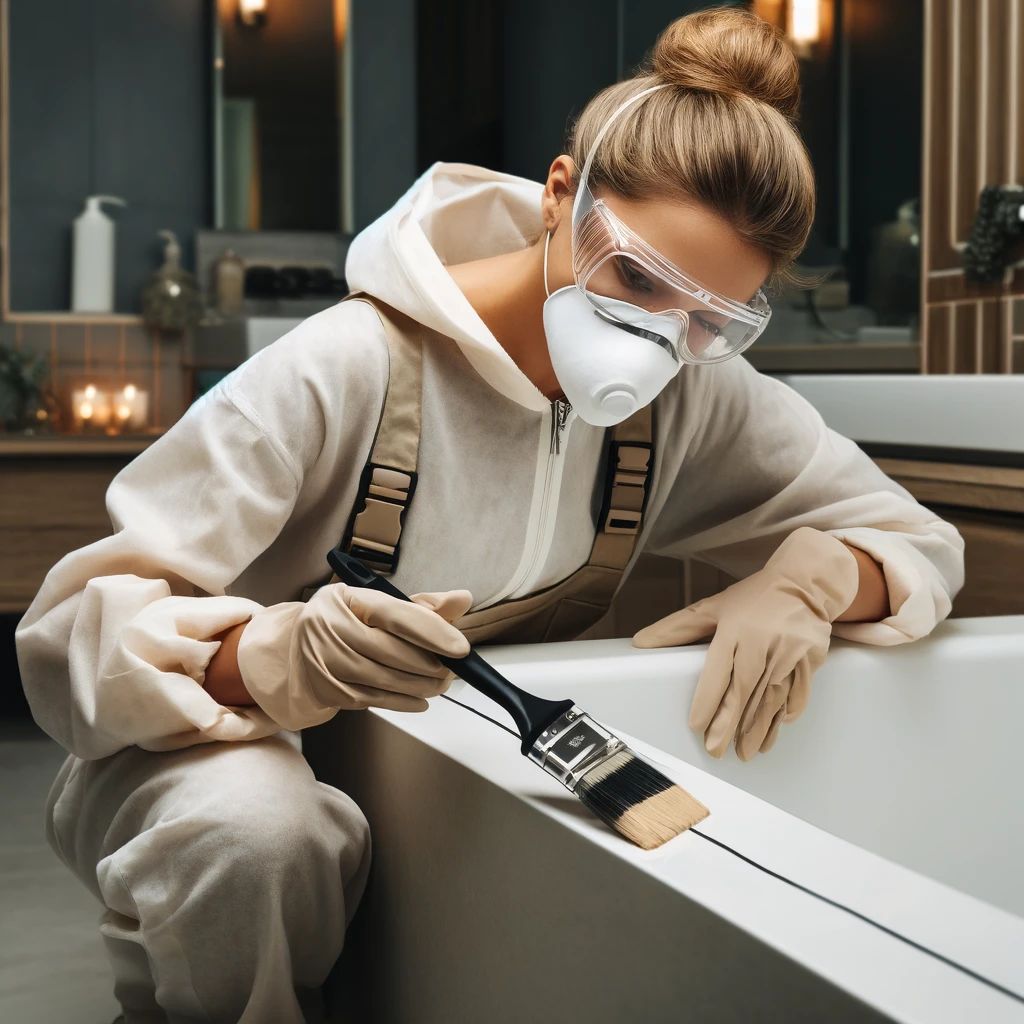
Key Takeaways
- DIY solid surface bathtub refinishing can significantly cut costs compared to professional services, usually costing under $100 for materials.
- Proper preparation, including thorough cleaning and sanding, is crucial for a successful refinishing job.
- Choosing the right refinishing kit for your tub’s material ensures a durable and long-lasting finish.
- Following detailed steps for cleaning, sanding, repairing, and applying finish is essential for a high-quality outcome.
- Regular maintenance after refinishing extends the life of your solid surface bathtub and keeps it looking new.
Revitalize Your Bathing Sanctuary
Imagine stepping into a bathroom where the bathtub gleams like it’s straight out of a glossy magazine. Now, picture achieving that look without the hefty price tag of a professional job. That’s the beauty of DIY bathtub refinishing, especially when it comes to solid surface tubs. It’s a project that not only saves money but also breathes new life into your bathroom. Let’s dive into transforming your tub from dull to dazzling.
What You Need to Know Before You Start
Let’s set the stage for your upcoming project. You’ve decided to take the plunge into DIY bathtub refinishing. Congratulations! This is not just a cost-effective decision but also an opportunity to put a bit of your own creativity and care into your home.
Before you begin, it’s important to assess your bathtub’s current condition. Is it just the color that bothers you, or are there chips and cracks too? Knowing the extent of wear will help you prepare for the tasks ahead.
Most importantly, safety first. Refinishing involves chemicals and fumes that can be hazardous. Ensure you have proper ventilation, protective gear, and follow all safety instructions on the products you’ll be using.
Why Choose DIY over Professional Refinishing
Professional refinishing can be costly, often ranging from $300 to $600, while DIY can be done for a fraction of that cost. Besides saving money, doing it yourself allows for full control over the project’s timeline and the satisfaction of completing a home improvement task on your own.
Gathering Your Supplies
Now, let’s talk about what you’ll need. You wouldn’t bake a cake without flour, right? Similarly, you can’t refinish a tub without the right supplies. Gather all your materials beforehand to ensure a smooth workflow.
The Essential Toolkit for Bathtub Refinishing
- Gloves and safety goggles
- A respirator to protect against fumes
- Quality bathtub cleaner
- Sanding paper or a sander
- Repair putty for cracks and chips
- Primer, refinishing paint, and sealer
- Tack cloth and painters’ tape
- A fan for ventilation
With your toolkit ready, you’re one step closer to a brand-new looking bathtub.
Selecting the Right Products for Your Tub’s Material
The type of tub you have dictates the products you’ll use. You can get a refinishing kit that is designed for solid surface tubs and these kits usually include everything from cleaner to finisher, ensuring a cohesive system that will adhere well and last long.
Now, roll up your sleeves. It’s time to transform your tub!

Solid Surface Bathtub Refinishing Steps
Refinishing a solid surface bathtub involves several steps to restore its beauty and functionality. Follow these steps to bring new life to your bathtub.
Step 1: Cleaning
Thoroughly clean the bathtub surface to remove any dirt, grime, or soap scum. Use a non-abrasive cleaner and rinse well. Any existing coatings or residues are stripped away using appropriate cleaning agents and techniques.
Wait for the tub to be fully dry before moving onto the next step.
Step 2: Repairing
Before we lay down any new finish, we need to ensure the surface is as smooth as a calm lake at dawn. Any chips, cracks, or imperfections will stand out like a sore thumb once the tub is refinished.
To repair these blemishes, use a repair putty or filler designed for your tub’s material. Apply it according to the manufacturer’s instructions, fill in the damaged areas, and allow it to dry completely. Once dry, sand the repaired areas until they’re flush with the tub’s surface. A smooth base is key to a flawless finish.
Step 3: Sanding
To prep your bathtub for a new coat, you’ll want to lightly sand the whole surface. This roughs it up a bit, helping the new coating stick better. Plus, it clears away any leftover residue and makes sure the surface is nice and clean for refinishing. Just grab some fine-grit sandpaper, around 220-grit should do, and give the entire tub a good once-over.
Step 4: Primer Application: Laying the Foundation
The primer really helps the new coating stick to the old surface by enhancing the bond between them. Here’s how you apply the primer:
- Choose a high-quality primer specifically formulated for solid surface materials.
- Apply a thin, even layer of primer over the entire surface of the tub.
- Allow the primer to dry as recommended before moving on to the next step. Patience here is key – rushing can lead to a less than perfect finish.
Step 5: Painting & Sealing
Now comes the moment of transformation – applying the finish. Whether you’re using a spray-on or brush-on product, the key is to apply thin, even coats. Start from one end and work your way to the other, maintaining a steady hand and consistent speed to avoid drips and streaks.
Between coats, take a breather. Let each layer dry thoroughly before applying the next. This isn’t just about watching paint dry; it’s about ensuring each layer has time to set properly, building up to a durable and smooth finish.
Painting: The Transformation Begins
As you apply the refinishing paint, you’ll see your tub start to transform. It’s like giving your bathtub a new lease on life. Remember to keep the room well-ventilated and to wear your respirator – safety is as important as precision in this step.
Sealing: Locking in the Fresh Look
Once the final coat of paint has dried, it’s time to seal your hard work. The sealing layer protects your finish from water, mold, and mildew – the nemeses of any bathroom fixture. Apply the sealant as directed, ensuring complete coverage for a watertight barrier.
Step 6: Buffing and Polishing Your Work
After the sealant has cured, it’s time to make your tub shine. Buffing smooths out any minor imperfections and prepares the surface for polishing. Use a non-abrasive buffing compound and a soft cloth to gently buff the surface of the tub.
Then, with a clean cloth, polish the tub to a brilliant shine. This step is like the cherry on top of your refinishing sundae – it’s what makes your tub look brand new again.
Buffing out the Rough Edges
When buffing, pay extra attention to any edges or areas where you’ve made repairs. These spots can sometimes show slight elevation changes or textural differences. A gentle, circular motion will help blend these areas seamlessly with the rest of the tub.
The Final Shine: Achieving a Professional Gloss
The polish you choose can make a big difference. Opt for a polish that’s suitable for your tub’s material and apply it with a microfiber cloth. The right polish will not only add a gleaming luster but also provide an additional layer of protection.

Valuable Tips for a Seamless DIY Journey
Refinishing a bathtub is a rewarding project, but it can have its challenges. Here are some insider tips to help you navigate the process smoothly.
Avoiding Common DIY Pitfalls
One common pitfall is not allowing enough drying time between steps. Another is not prepping the surface properly. To avoid these, plan your project with ample time and don’t skip any preparatory steps.
Ensure your bathroom is well-ventilated throughout the process. This not only protects your health but also aids in the drying process.
Dealing with Bubbles and Runs
Bubbles can form if you shake your finish can too vigorously or if you apply too thick a coat. Runs happen when the paint is applied too heavily or if the tub isn’t level. Tackling these issues quickly will keep your finish smooth and even.
Uneven Settling of Finish
If you notice the finish isn’t settling evenly, it could be due to uneven application or varying temperatures in the room. To fix this, apply additional thin coats only to the affected areas, blending them into the surrounding finish. Always allow for full drying time between coats.
Caring for Your Newly Refinished Tub
After all your hard work, you’ll want to keep that tub looking magnificent. The key is gentle, regular maintenance. Avoid harsh chemicals and abrasive cleaners; instead, opt for mild soap and a soft cloth for cleaning. It’s also wise to avoid leaving any products like shampoo bottles or soap directly on the surface for extended periods, as they can stain or damage the finish. Treat your refinished tub with care, and it will reward you with years of glossy service.

Frequently Asked Questions
How Long Does the Refinishing Process Take?
Typically, the refinishing process can be completed in a weekend. However, it’s not just about the active work—drying and curing times are critical. From the initial cleaning to the final polish, expect to set aside at least 48 to 72 hours before you can use your tub again. And remember, good things come to those who wait!
Can You Refinish a Tub with Significant Damage?
If your tub has significant damage, like large cracks or holes, it might be beyond the scope of a simple DIY job. Small blemishes can usually be repaired with filler, but major damage often requires professional intervention or even a tub replacement. Assess the damage carefully before deciding on the best course of action.
What’s the Best Way to Maintain a Refinished Tub?
The best way to maintain your refinished tub is through gentle, consistent cleaning. Avoid any products that contain acetone or bleach, and steer clear of scrubbing pads. A simple solution of vinegar and water works wonders for keeping your tub’s new finish in top condition. Also, make sure to fix leaky faucets quickly, as constant dripping can wear away the finish over time.
How Often Should You Refinish Your Bathtub?
How often you should refinish your bathtub depends on usage and how well it’s maintained. On average, a refinished tub can last 10 to 15 years before needing another overhaul. If you notice the gloss beginning to dull or the color starting to fade, it might be time to consider a touch-up.
Do You Need to Hire a Professional to Refinish a Bathtub?
While hiring a professional is always an option, it’s not a necessity for those who are willing to put in the effort. If you’re comfortable with hands-on projects and can follow detailed instructions, DIY refinishing is a viable and satisfying option. However, if the thought of dealing with chemicals and meticulous work makes you uneasy, or if your tub requires extensive repairs, a professional might be the way to go.





Leave a Reply